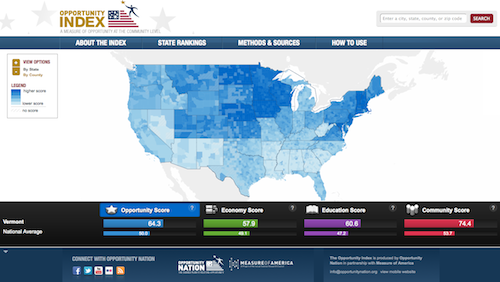Your Zip Code Shouldn’t Determine Your Economic Fate
•At the core of the Opportunity Nation campaign is the idea that, in America, the circumstances of your birth, the community you grow up in, should not condemn you or any person to an inescapable economic fate.
We talk a lot about the challenges we face as a nation: the jobs crisis, persistent poverty, failing schools, and more. And we know the potential waiting to emerge when all our friends and neighbors find work and have the skills to succeed.
But we know from our lived experience that the ladder of opportunity in some communities has stronger rungs than others – safe communities to go to school, schools that prepare you to graduate and build a career, decent wages to help you afford a home.
That is why we developed the Opportunity Index in 2011 – to assess the strength of these various rungs. Developed in partnership with Measure of America, a project of the Social Science Research Council and with support and engagement from United Way Worldwide and our coalition, the Index measures the conditions present in different communities that constrain or expand opportunity. Unlike personal characteristics, which also have an impact on mobility, these factors are amenable to policy change and to collective efforts to bring about improvements for a community’s residents.
We use the data in sixteen indicators to derive an Opportunity Score, a comprehensive snapshot of where a community stands today and how it can improve its future.
Last week, as part of Opportunity Nation’s national Summit in Washington, DC, we released the second annual Opportunity Index, which for the first time will allow us to identify which communities are making progress in strengthening the rungs on the ladder, and which areas still need more work.
In this post – the first of many over the coming weeks – I’ll share some of the top regional and state findings from the 2012 Opportunity Index.
Future posts will talk about specific communities that are leading the country in enhancing opportunity, activities on the ground that are helping lift communities up, and efforts by partner organizations that are helping raise opportunity scores.
But I encourage you to do your own research too. Visit www.opportunitindex.org and enter in your zip code to see how your area ranks and see if it has made progress or fallen behind over the past year.
For now, here are some of the most interesting early takeaways from the 2012 Opportunity Index:
- The Northeast and Midwest dominate the highest ranks of the state Opportunity Scores, with the top ten states split evenly between the two regions.
- The sixteen Southern states are disproportionately represented in the bottom of the ranking, with only the four Southern states around the nation’s capital not clustered near the bottom.
- The eleven Western states largely occupy the middle to lower-middle rankings, with three at the very bottom.
- The top three states in the Opportunity Index are Vermont, North Dakota, and Minnesota. Interestingly, None of these three states are among the wealthiest as measured by income, yet they excel in many other important qualities. They have some of the lowest unemployment and poverty rates and proportions of youth not working or in school, and rank the highest of the concentration of primary care providers and high school graduation rates.
- The bottom three states on the Opportunity Index are New Mexico, Mississippi, and Nevada. Across all three dimensions, they score far below the national average, especially in terms of education. While three-quarters of American high school freshmen graduate in four years, these three states fall at the bottom of the pack: just over half of Nevada’s freshmen graduate on time. These states are also lagging well behind the national average in higher education attainment. The one area where Nevada excels is income, but higher median incomes are found alongside the highest unemployment rate of any state in the nation today.
Our ten-year goal is to improve Opportunity Scores by at least 10 percent in all 50 states. When opportunity grows, we all benefit.
Get Involved in the campaign and help improve opportunity across the country.









